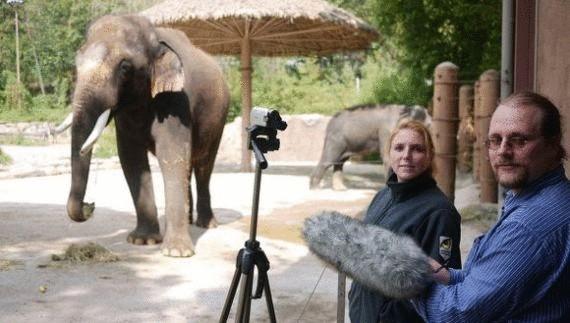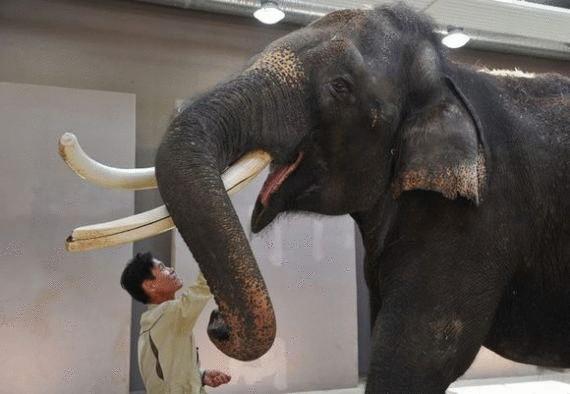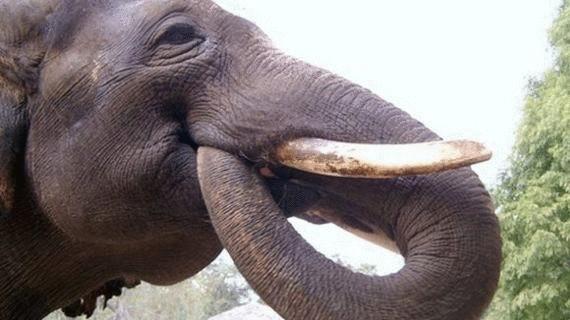618
Talking elephant named koshik
An Asian elephant named koshik has amazed scientists with his language skills.
As the researchers report that the mammal has learnt to imitate human speech and can say five words in Korean: "Hello", "no", "sit", "lie" and "good".
Pet puts in his mouth the tip of the trunk to make his natural low rumble similar to a human voice.

The ability of Kaushik suggests that elephants have joined a growing number of animals that are able to mimic man, from parrots and mynahs, to the more unusual such as sea lions and Beluga whales.
The study's lead author Dr. Angela Steger (University of Vienna; Austria) first learned about the Kaushik saw a video on YouTube about the elephant from Everland zoo (South Korea).
Contact the zoo, she went to South Korea to record voice and to explore the extraordinary abilities of the animal.
Then she and her colleagues asked native Korean speakers who have never heard about an unusual elephant, to state in writing that they understand, listening to a voice recording Kaushik.
The result was a high degree of conformity of common sense. The researchers found that the sounds uttered by Kaushik, correlated to five Korean words: "Aniene" (Hello), "Anja" (sit), Ani (no); "nuo" (lie down) and "Chua" (good).
In an interview with the BBC Dr. Stager said, "Human speech has two important characteristics: height (how high or low sound) and timbre (the musical quality of the voice); and Kaushik corresponds to each of these two characteristics."

Elephants normally produce much deeper sounds, sometimes so low frequency that they are beyond the range of human hearing, and these sounds can be heard at a distance of many kilometers.
To convert these typical elephant noises into something much more similar to a human voice, koshik uses his trunk. According to the researchers, this behavior they haven't seen.
"He always puts in his mouth the tip of his trunk, and then modulates the oral cavity," explains Dr. Stoker.

The researchers did not use fluoroscopy, so that they do not actually know what happens in the mouth of Kaushik, but, in their opinion, he invented a new way of sound production to match his two-legged comrades.
Taking into account the anatomical features of the elephant (long vocal tract, trunk instead of lips, huge throat, etc.), the ability of Kaushik seem really awesome.
However, despite this, the researchers do not believe that the animal understands the meaning of the words that it pronounces.
According to them, the elephant began to speak in order to communicate with their two-legged companions.
At the age of 5-12 years koshik was the only elephant in the zoo of the Everland amusement and, as the researchers noted, this period was a turning point for its development.
Dr. Stover explained: "People were his only social contact, and, according to our assumptions koshik is using these vocalizations as a way of strengthening social ties with his companions, which in this case are people."
Source: /users/104
As the researchers report that the mammal has learnt to imitate human speech and can say five words in Korean: "Hello", "no", "sit", "lie" and "good".
Pet puts in his mouth the tip of the trunk to make his natural low rumble similar to a human voice.

The ability of Kaushik suggests that elephants have joined a growing number of animals that are able to mimic man, from parrots and mynahs, to the more unusual such as sea lions and Beluga whales.
The study's lead author Dr. Angela Steger (University of Vienna; Austria) first learned about the Kaushik saw a video on YouTube about the elephant from Everland zoo (South Korea).
Contact the zoo, she went to South Korea to record voice and to explore the extraordinary abilities of the animal.
Then she and her colleagues asked native Korean speakers who have never heard about an unusual elephant, to state in writing that they understand, listening to a voice recording Kaushik.
The result was a high degree of conformity of common sense. The researchers found that the sounds uttered by Kaushik, correlated to five Korean words: "Aniene" (Hello), "Anja" (sit), Ani (no); "nuo" (lie down) and "Chua" (good).
In an interview with the BBC Dr. Stager said, "Human speech has two important characteristics: height (how high or low sound) and timbre (the musical quality of the voice); and Kaushik corresponds to each of these two characteristics."

Elephants normally produce much deeper sounds, sometimes so low frequency that they are beyond the range of human hearing, and these sounds can be heard at a distance of many kilometers.
To convert these typical elephant noises into something much more similar to a human voice, koshik uses his trunk. According to the researchers, this behavior they haven't seen.
"He always puts in his mouth the tip of his trunk, and then modulates the oral cavity," explains Dr. Stoker.

The researchers did not use fluoroscopy, so that they do not actually know what happens in the mouth of Kaushik, but, in their opinion, he invented a new way of sound production to match his two-legged comrades.
Taking into account the anatomical features of the elephant (long vocal tract, trunk instead of lips, huge throat, etc.), the ability of Kaushik seem really awesome.
However, despite this, the researchers do not believe that the animal understands the meaning of the words that it pronounces.
According to them, the elephant began to speak in order to communicate with their two-legged companions.
At the age of 5-12 years koshik was the only elephant in the zoo of the Everland amusement and, as the researchers noted, this period was a turning point for its development.
Dr. Stover explained: "People were his only social contact, and, according to our assumptions koshik is using these vocalizations as a way of strengthening social ties with his companions, which in this case are people."
Source: /users/104




















